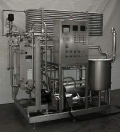The Pasteurization Process
A Brief History:

Though not as well-known as the man who gave his name to this process, Italian biologist Lazzaro Spallanzani (1729-1799,
right) laid the groundwork for germ theory by showing that microbes do not just 'appear' spontaneously.
His early work with the heat sterilization of food in the 1760's formed the basis for research done by French chemist Louis Pasteur (1822-1895) nearly a century later.
In the 1850's, Pasteur (
below, right) began to examine why products like wine and beer sometimes went sour during the fermentation process. This led to his discovery that the souring was caused by certain unwanted strains of bacteria and yeast, or 'germs,' as he called them.

Taking a cue from Spallanzani, he found that heating below boiling, then rapidly cooling wine, killed the spoilage organisms busily trying to turn it into vinegar. This heat sterilization process, dubbed 'pasteurization' (not 'pasture-ization' as some call it), was first proposed for use on milk in 1886 by German agricultural chemist Franz von Soxhlet.
The first commercial pasteurization machines came on-line in the mid-1890's and remained the standard for decades. Recently, ultra-high temperature pasteurization, commercially available since 1948, has become more common due to the increased shelf-life and total sterilization it gives milk.
Types of Pasteurization:

There are basically two methods of pasteurization in use today- batch and continuous flow.
In the batch process (batch pasteurizer, right) , a large quantity of milk is held in a heated vat at 149°F./65°C. for 30 minutes, followed by quick cooling to about 39°F./4°C.
In the continuous flow process (continuous flow pasteurizer, below, right)-also known as HTST, for high temperature, short time, milk is forced between metal plates or through pipes heated on the outside by hot water.

While flowing under pressure, the milk is held at 161°F/72°C. for at least 16 seconds. Before being chilled back to 39°F./4°C. or cooler, it flows through a heat exchanger to pre-warm cold milk just entering the system.
Effects of Pasteurization:
The ultimate goal in heat treating milk is the destruction of all pathogenic or disease-causing microbes. Usually (but not always), assuming the machinery is functioning properly, the process accomplishes this task effectively.
Numerous studies have shown, however, that bad bugs are not the only thing destroyed by the heat: delicate proteins, enzymes, immune factors, hormones, vitamins, mineral availability- all undergo definite changes during the heating process. No one seriously disputes this fact.
What is not clear though, due to conflicting science and belief systems, is to what extent the food value of the milk is actually impacted. When man-made nutrients (often inferior to their natural form) must be added back in to replace those destroyed by heat, there is no argument. The quality of the milk has suffered.
And who speaks for the hundreds of factors and components present in raw milk, known and unknown, that synergistically create a whole, healing food?
What truly becomes of raw milk's many natural hormones, immune modulators and enzymes if, say, certain other key substances designed to assist their proper function are ultimately destroyed (and not replaced)?
Is the calcium our bodies absorb from pasteurized dairy somehow altered so that it goes to places other than needed or wanted? The unanswered questions continue to pile up...
Raw milk is an incredibly complex substance, the science of which we've still only begun to tweeze apart. Bear in mind, also, that the majority of milk research from the mid 1940's on has been, and continues to be, performed using pasteurized product.
There's no question that pasteurization, while far from flawless, is a valuable and necessary process, especially where factory-farmed milk is concerned, but the ability to buy and consume clean, living foods with their myriad bits and pieces intact should also be an option for those who so choose.